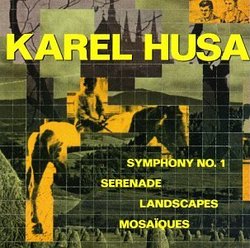| All Artists: Husa, Prague Symphony Title: Symphony 1 / Serenade / Landscapes Members Wishing: 0 Total Copies: 0 Label: Composers Recordings Release Date: 4/20/1994 Genres: Jazz, Classical Styles: Chamber Music, Historical Periods, Modern, 20th, & 21st Century, Symphonies Number of Discs: 1 SwapaCD Credits: 1 UPC: 090438059220 |
Search - Husa, Prague Symphony :: Symphony 1 / Serenade / Landscapes
 | Husa, Prague Symphony Symphony 1 / Serenade / Landscapes Genres: Jazz, Classical
|
Larger Image |
CD Details |
CD ReviewsA good overview of Husa's many compositional styles Discophage | France | 02/11/2007 (4 out of 5 stars) "This well-filled (77:44) disc from Composers Recordings Inc. (CRI) was published in 1991 and gathers recordings made in 1967 (Mosaïques), 1970 (Symphony and Serenade) and 1977 (Landscapes). The three earlier ones bear the imprimatur of being composer-conducted. The remastering has produced excellent, up-to-date sound. On the original LPs Mosaïques was coupled with Hovhaness' Triptych and Straight's Development for orchestra on CRI 221, Landscapes came on CRI 192 with works by Haufrecht and Mourant and the Symphony and Serenade made up CRI S-261, which also had the Nocturne from the Fantasies for orchestra.
Karel Husa was born in Prague, Czechoslovakia in 1921 and received his initial music training in his home country. He resided in Paris from 1947 to 1954 under a French grant, resisting a summon from the Czech government spawn from the Communist seizure of power in the early months of 1948 to return to his homeland. In Paris he studied composition with Honegger and Nadia Boulanger and conducting with Eugène Bigot, Jean Fournet and André Cluytens, and already attracted some attention as a composer, earning prizes for his 1st string quartet from 1948. In 1954 he answered an invitation of Cornell University in Ithaca, New York, to become composition teacher, and established himself in the United States. He became a US citizen in 1959 and remained at Cornell until his retirement in 1992. His 3rd String Quartet earned him the coveted Pulitzer Prize in 1969 (the Everest recording by the Fine Arts Quartet has been reissued on CD by Phoenix), and his dramatic and effective Music for Prague, written in 1968 in reaction the Soviet invasion of Czechoslovakia, first for Wind ensemble then re-scored for full symphony orchestra, became Husa's more popular piece, with more than 8,000 performances to date. The first Symphony is a work of exceptional quality, not only "given its date of composition" (it was written in 1951 and thus belongs to the composer's early works) but in itself. Though traces of Bartok and Honegger can be heard (as the liner notes point out), Husa's language is more advanced and daring than both. It is a knotty, highly dramatic piece, rising to heights of tremendous and breathtaking power such as Hindemith has attained in the best of his symphonic pieces, and the composer's taste for new sonorities and instrumental combinations is already much in evidence, making sound like a full-blooded concerto for orchestra. Mosaïques for orchestra was written in 1961 and is the piece in which Husa's style is at its most "mainstream post-webernian serialist", such as was prevalent in Darmstadt and Donaueschingen in those days. It consists of 5 sections (the mosaics of the title), each scored for different instrumental groupings. The first movement starts with a terse, enigmatic succession of isolated notes played by percussion instruments (including piano & harp), composing an echt "Farbenmelodie" (melody of colors). The second and fifth are scored predominantly for strings, whose sinuous melody evoke Schoenberg's variations op 31, with coloristic punctuations from percussion and harp. Brass and woodwinds are predominant in the agitated and dramatic central movement which functions as a scherzo of quasi-cinematographic scope. Not easily accessible music, but well crafted in its own style, as well as effective and dramatic. Though written in 1963, the Serenade (for Woodwind Quintet, String orchestra, Harp and Xylophone) harks back to Janacek. The mood in the two outer movements is mischievous and sardonic, like an evocation of Till Eulenspiegel and there is much drama in the middle one. The language is rather traditional and not entirely personal. Landscapes for Brass Quintet is the latest work (1977) and the most advanced in its compositional techniques. It bears the hallmarks of Husa at his most original, with an exploration of non-traditional playing modes and novel sonorities. Especially striking are the 2nd movement and the beginning of the 3rd, which play in the softest possible, hushed dynamics, with quarter-tone slides. The picture that emerges is that of a composer of variegated styles, always striving to keep abreast of the latest developments in compositional outlooks and styles, but never relinquishing expressivity and dramatic impact. As he stated a few years ago, "I accept new things. I'm not revolting against something new. On the contrary, I think there must be some potential good in new things. (...) The avant guard is the faction that keeps us going on ahead" This may not be the best and most accessible introduction to the music of Karel Husa (try rather the Marco Polo CD with Fresques, 2nd Symphony "Reflections" and Music for Prague, or the Phoenix CD with Quartets 2 & 3) but it is a good complement to any of these for the listener trying to expand his familiarity with the composer. But caution; it is NOT worth the prices asked for it by some internet vultures who try to take advantage of the disc's unavailability due to the label's unfortunate demise in 2003. " |

 Track Listings (9) - Disc #1
Track Listings (9) - Disc #1